Tolles-Lawson Compensation
IEEE/ION PLANS 2023, Monterey, CA
The views expressed in this article are those of the author and do not necessarily reflect the official policy or position of the United States Government, Department of Defense, United States Air Force or Air University.
Distribution A: Authorized for public release. Distribution is unlimited. Case No. 2023-0277.
https://rpubs.com/friendly/test-newcommands https://quarto.org/docs/authoring/markdown-basics.html#equations
https://stackoverflow.com/questions/41362012/how-to-insert-font-awesome-icons-in-mathjax
Font-Awesome will only work for html type output
\[ \newcommand{\dvec}[1]{\dot{\vec{#1}}} \newcommand{\ddvec}[1]{\ddot{\vec{#1}}} \newcommand{\mat}[1]{\mathbf{#1}} \newcommand{\earth}{{\oplus}} \newcommand{\ext}{\text{ext}} \newcommand{\faPlane}{\class{fa fa-plane}{}} \newcommand{\plane}{\class{fa fa-plane}{}} \newcommand{\sensor}{\text{Sensor}} \]
Tolles-Lawson
- Calibration technique developed in WW2 for submarine hunting
- Declassified in 1950’s and patented
- Standard calibration technique used for aero-magnetic surveys
- Developed by (Leliak 1961)

\[ \begin{align*} |B_\mathrm{Sensor}| &= |\vec{B}_\ext + \vec{B}_\faPlane|\\ &= \sqrt{ |B_\ext|^2 + |B_\faPlane|^2 + 2 |B_\ext||B_\faPlane|\cos\theta}\\ |B_\text{Sensor}| &= |B_\ext| \sqrt{ 1 + \frac{|B_\faPlane|^2}{|B_\ext|^2} + 2\frac{|B_\faPlane|}{|B_\ext|}\cos\theta} \end{align*} \]
Tolles-Lawson Path to Calibration 1/2
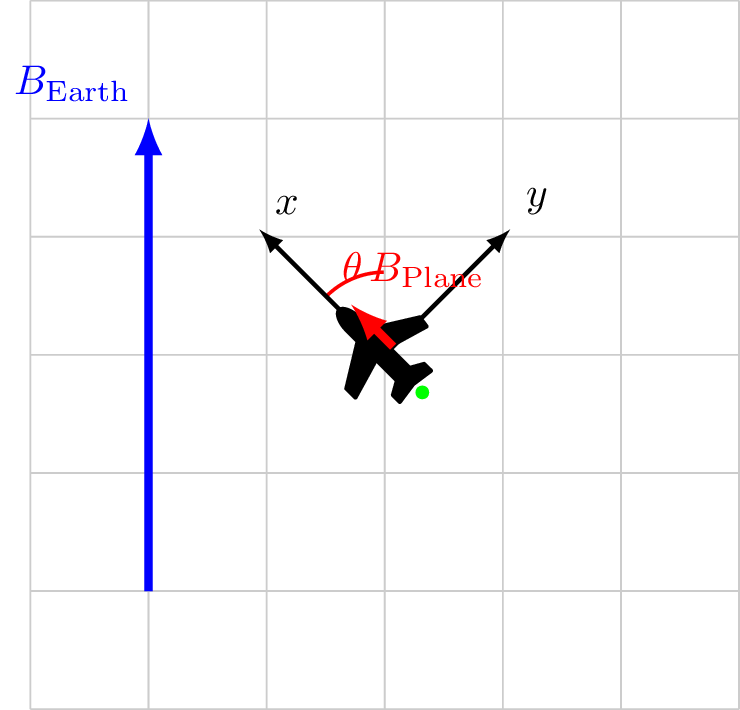
\[
\begin{align*}
|B_\text{Sensor}| &= |\vec{B}_\ext + \vec{B}_\faPlane|\\
&= \sqrt{ |B_\ext|^2 + |B_\faPlane|^2 + 2 |B_\ext||B_\faPlane|\cos\theta}\\
|B_\text{Sensor}| &= |B_\ext| \sqrt{ 1 + 2\frac{|B_\faPlane|}{|B_\ext|}\cos\theta}\\
&\approx |B_\ext| + |B_\faPlane|\cos\theta + \cdots
\end{align*}
\]
Path to Calibration
Measure \(\cos\theta\)
Solve \(|B_\text{sensor}| = |B_\ext| + |B_\plane|\cos\theta\)
Assuming \(|B_\ext|\) is known or constant
Tolles-Lawson Path to Calibration 2/2
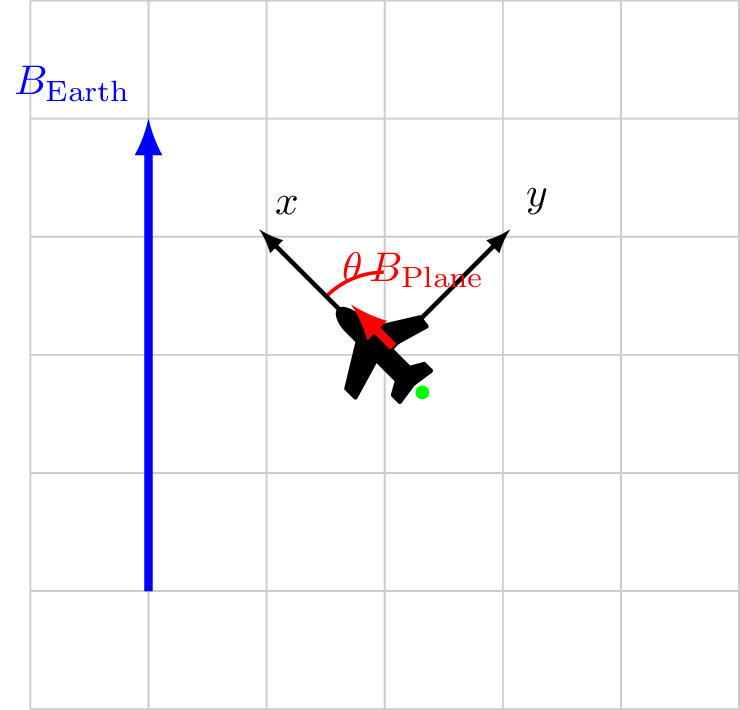
Path to Calibration
Measure \(\cos\theta\)
Solve \(|B_\text{sensor}| = |B_\ext| + |B_\faPlane|\cos\theta\)
Assuming \(|B_\ext|\) is known or constant
How to measure \(\cos\theta\)?
Use a vector magnetometer
Rotate aircraft in \(|B_\ext|\)
Compute direction cosines…
Direction cosines
- The direction cosines are computed in the vector magnetometer reference frame
- The magnetometer is fixed to aircraft body reference frame \[ \begin{aligned} \cos X = & \frac{B_x}{\sqrt{B_x^2 + B_y^2 + B_z^2}}\\ \cos Y = & \frac{B_y}{\sqrt{B_x^2 + B_y^2 + B_z^2}}\\ \cos Z = & \frac{B_z}{\sqrt{B_x^2 + B_y^2 + B_z^2}} \end{aligned} \]
In the 2-D example, \(B_z = 0\)
Calibration 1/4

Coordinate system fixed to aircraft
\[\vec{B}_\mathrm{Sensor} = \vec{B}_\ext + \vec{B}_\faPlane\]
\[
\begin{alignat*}{3}
\vec{B}_\ext &= 4.0 \hat{x} && + 0.0 \hat{y} \\
\vec{B}_\faPlane &= 0.5 \hat{x} && +0.0 \hat{y} \\
\vec{B}_\text{Sensor} &= 4.5 \hat{x} && + 0.0 \hat{y} \\
|B_\text{Sensor}| &= 4.5 && \\
\cos X &= \frac{4.5}{4.5} && = 1\\
\cos Y &= \frac{0.0}{4.5} && = 0\\
\end{alignat*}
\]
Calibration 2/4
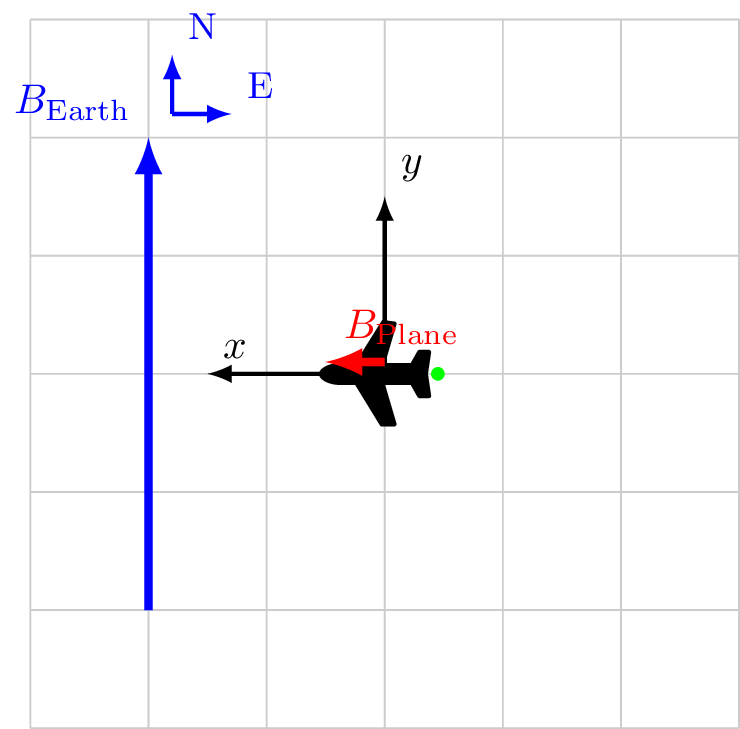
Coordinate system fixed to aircraft
\[\vec{B}_\text{Sensor} = \vec{B}_\ext + \vec{B}_\faPlane\]
\[
\begin{alignat*}{3}
\vec{B}_\ext &= 0.0 \hat{x} && + 4.0 \hat{y} \\
\vec{B}_\faPlane &= 0.5 \hat{x} && + 0.0 \hat{y} \\
\vec{B}_\text{Sensor} &= 0.5 \hat{x} && + 4.0 \hat{y} \\
|B_\text{Sensor}| &= 4.007 && \\
\cos X &= \frac{0.5}{4.007} && \ne 0 \rightarrow 82.8^\circ\\
\cos Y &= \frac{4.0}{4.007} && \approx 1\\
\end{alignat*}
\]
Calibration 3/4
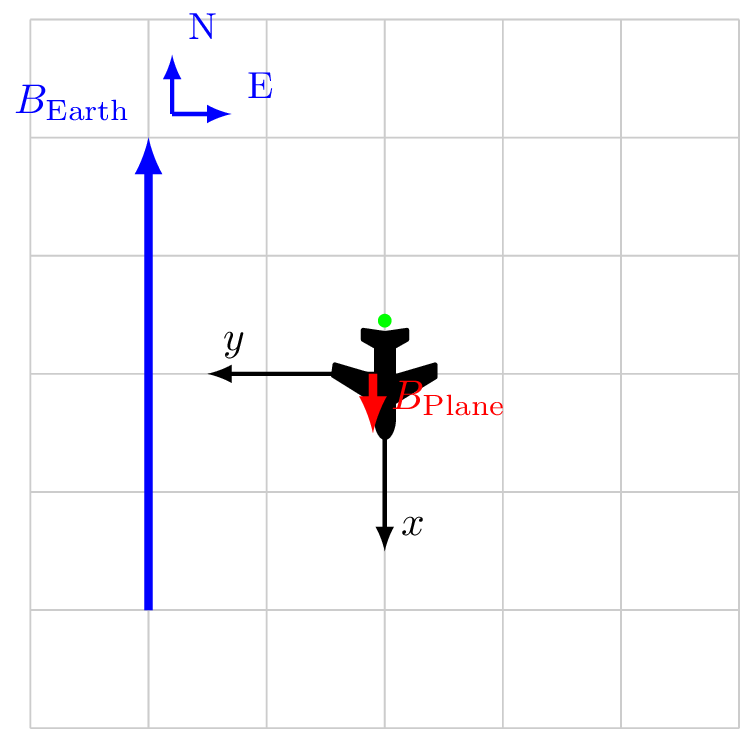
Coordinate system fixed to aircraft
\[\vec{B}_\text{Sensor} = \vec{B}_\ext + \vec{B}_\faPlane\]
\[
\begin{alignat*}{3}
\vec{B}_\ext &= -4.0 \hat{x} && + 0.0 \hat{y} \\
\vec{B}_\faPlane &= 0.5 \hat{x} && + 0.0 \hat{y} \\
\vec{B}_\text{Sensor} &= -3.5 \hat{x} && + 0.0 \hat{y} \\
|B_\text{Sensor}| &= 3.5 && \\
\cos X &= \frac{-3.5}{3.5} && = -1\\
\cos Y &= \frac{0}{3.5} && = 0\\
\end{alignat*}
\]
Calibration 4/4
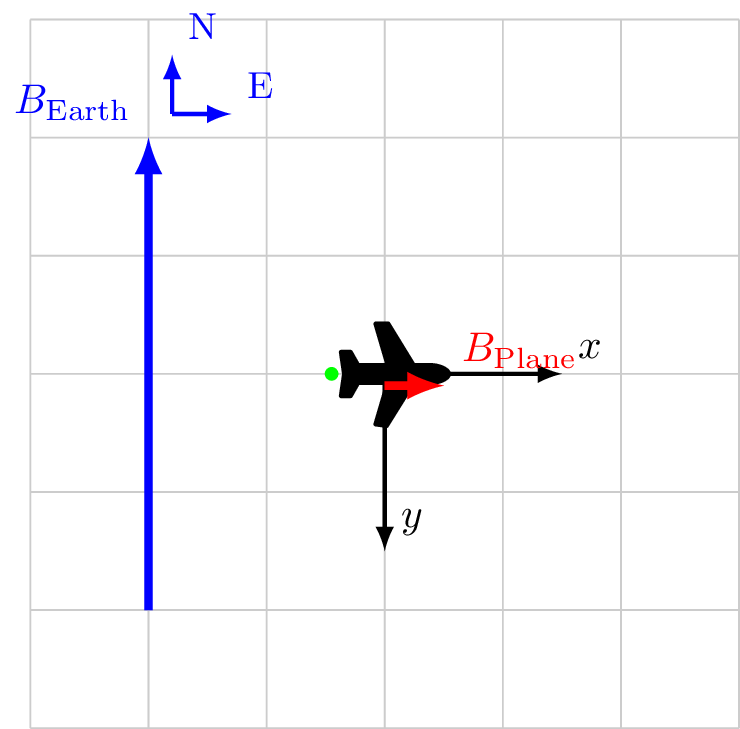
Coordinate system fixed to aircraft
\[\vec{B}_\text{Sensor} = \vec{B}_\ext + \vec{B}_\faPlane\]
\[
\begin{alignat*}{3}
\vec{B}_\ext &= 0.0 \hat{x} && + -4.0 \hat{y} \\
\vec{B}_\faPlane &= 0.5 \hat{x} && + 0.0 \hat{y} \\
\vec{B}_\text{Sensor} &= 0.5 \hat{x} && + -4.0 \hat{y} \\
|B_\text{Sensor}| &= 4.007 &&\\
\cos X &= \frac{0.5}{4.007} && \ne 0\\
\cos Y &= \frac{-4.0}{4.007} && \approx -1\\
\end{alignat*}
\]
Standard calibration model
\[|\vec{B}| = |\vec{B}_\ext + \vec{B}_\faPlane|\]
\[ \begin{array}{ l B c B c B c } \vec{B}_\faPlane & = & \vec{B}_\text{Permanent} & + & \vec{B}_\text{Induced} & + & \vec{B}_\text{Eddy}\\ & = & \vec{P}_\text{constant} {} & + &{} M_{3\times3} \vec{B }_\ext {} & + & {} S_{3\times3} \frac{\partial}{\partial t} \vec{B}_\ext \end{array} \]
\(M_{3\times3}\) is symmetric \(\rightarrow\) 6 independent elements
Total of 18 elements

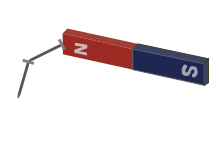
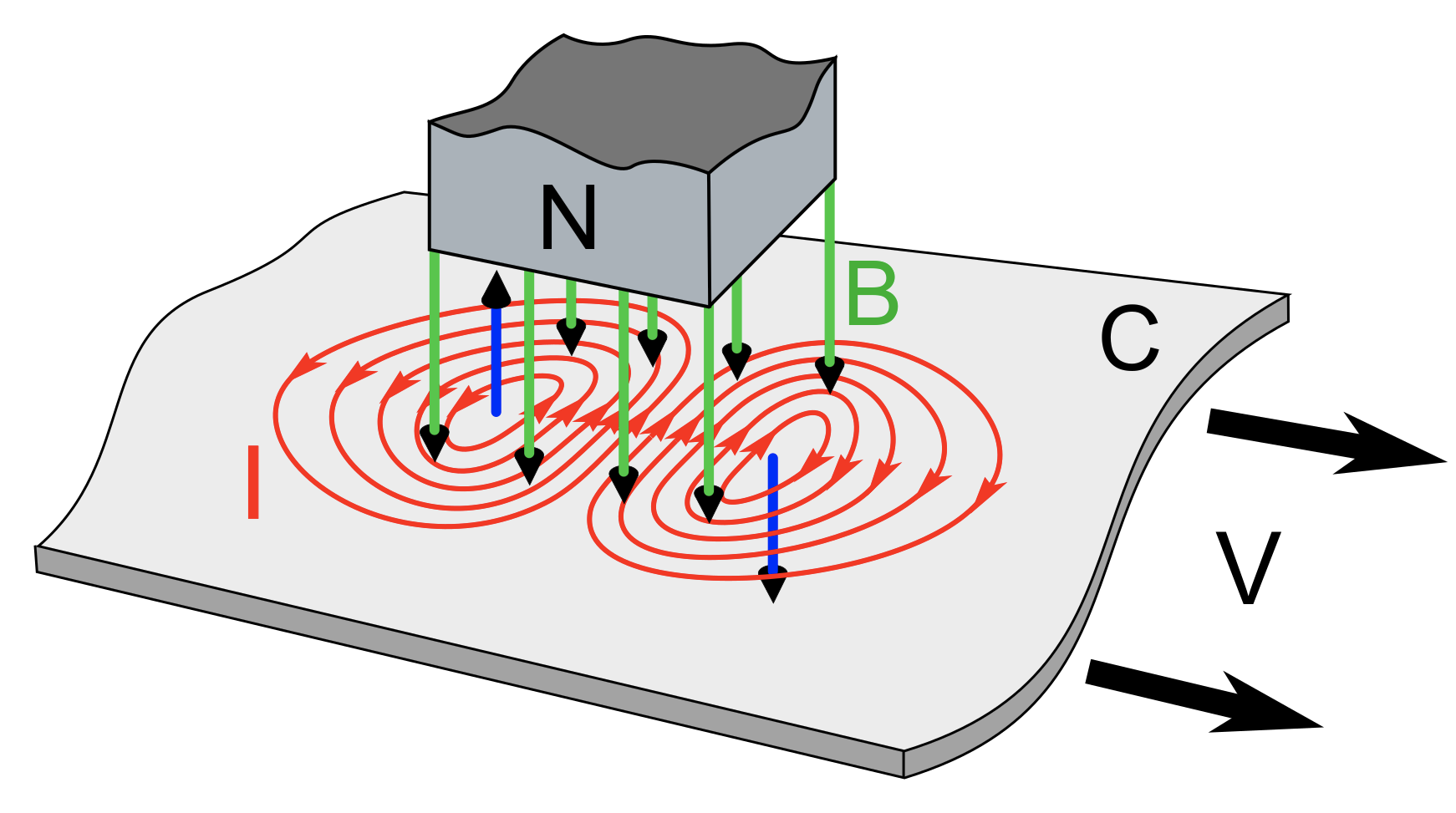
Use the same direction cosines, now with \(B_z\)
The direction cosines are computed from the vector magnetometer
\[ \begin{aligned} \cos X = & \frac{B_x}{\sqrt{B_x^2 + B_y^2 + B_z^2}}\\ \cos Y = & \frac{B_y}{\sqrt{B_x^2 + B_y^2 + B_z^2}}\\ \cos Z = & \frac{B_z}{\sqrt{B_x^2 + B_y^2 + B_z^2}} \end{aligned} \]
Tolles-Lawson full implementation
\[
\begin{aligned}
B_\plane & = & & { c_1 \cos X + c_2 \cos Y + c_3 \cos Z }+ \\
& & B_\ext & {[ c_4 \cos^2 X + c_5 \cos X \cos Y + c_6 \cos X \cos Z +} \\
& & & { c_7 \cos^2 Y + c_8 \cos Y \cos Z + c_9 \cos^2 Z ] + } \\
& & B_\ext & { [ c_{10} \cos X \cos' X + c_{11} \cos X \cos' Y + c_{12} \cos X \cos' Z }+ \\
& & & { c_{13} \cos Y \cos' X + c_{14} \cos Y \cos' Y + c_{15} \cos Y \cos' Z +} \\
& & & { c_{16} \cos Z \cos' X + c_{17} \cos Z \cos' Y + c_{18} \cos Z \cos' Z ] }
\end{aligned}
\]
We need a method to solve for \(c_1 \ldots c_{18}\)
How to sample the range of possible angles?
Calibration manuevers - Tolles-Lawson
Fly the aircraft in a series of Roll, Pitch, Yaw maneuvers
High-altitude
Altitude of a known map
Maneuver angle should depend upon the expected aircraft dynamics
- Barrel Rolls?
Typically at each cardinal heading
- 3 rolls \(\pm 10^\circ\) at 1 Hz
- 3 pitches \(\pm 10^\circ\) at 1 Hz
- 3 yaws \(\pm 10^\circ\) at 1 Hz
Pack your air-sickness bag
(W. E. Tolles and Lawson 1950), (W. E. Tolles 1954), (W. E. Tolles 1955), (Gnadt, Wollaber, and Nielsen 2022)

Construct Tolles-Lawson \(A\) matrix
\[ A = \begin{bmatrix} \cos X_1 & \cdots & \cos X_N\\ \cos Y_1 & \cdots & \cos Y_N \\ \cos Z_1 & \cdots & \cos Z_N\\ B_\ext \cos^2 X_1 & \cdots & B_\ext \cos^2 X_N\\ B_\ext \cos X_1 \cos Y_1 & \cdots & B_\ext \cos X_N \cos Y_N\\ B_\ext \cos X_1 \cos Z_1 & \cdots & B_\ext \cos X_N \cos Z_N \\ B_\ext \cos^2 Y_1 & \cdots & B_\ext \cos^2 Y_N \\ B_\ext \cos Y_1 \cos Z_1 & \cdots & B_\ext \cos Y_N \cos Z_N\\ B_\ext \cos^2 Z_1 & \cdots & B_\ext \cos^2 Z_N\\ B_\ext \cos X_1 \cos' X_1 & \cdots & B_\ext \cos X_N \cos' X_N \\ B_\ext \cos X_1 \cos' Y_1 & \cdots & B_\ext \cos X_N \cos' Y_N\\ B_\ext \cos X_1 \cos' Z_1 & \cdots & B_\ext \cos X_N \cos' Z_N\\ B_\ext \cos Y_1 \cos' X_1 & \cdots & B_\ext \cos Y_N \cos' X_N\\ \vdots & & \vdots \\ B_\ext \cos Z_1 \cos' Z_1 & \cdots & B_\ext \cos Z_N \cos' Z_N \\ \end{bmatrix} \]
\(B_\ext\) is the magnitude of the external field. We assume that \[
B_\ext = \sqrt{B_x^2 + B_y^2 + B_z^2}
\]
Equivalently that the vector mags only see external field. The anomaly signal is below the noise floor.
Solve for the \(c_i\) coefficients
Map-less calibration
Perform maneuvers at fixed frequency \(f\)
Band-pass filter columns of \(A\), \(B_\text{scalar}\) \[
\begin{aligned}
A_f & = BPF(A)\\
B_{\text{scalar},f} & = BPF(B_{\text{scalar}})
\end{aligned}
\]
Solve for \(c\)
\[
A_f c = B_{\text{scalar},f}
\]
Map-based calibration
Perform maneuvers over known-good map
Solve for \(c\)
\[
A c = B_{\text{sensor}} - B_{\earth} - B_{\text{anomaly}}
\]
Apply \(c\) to in-flight data for comparison
In-flight
Compute \(A_i\) for each time-step
Apply \(c\)
\[
B_\text{plane} = A c
\]
\[
B_\text{anomaly} = B_\text{sensor} - B_\earth - B_\faPlane
\]

ION/IEEE PLANS MagNav Tutorial 2023